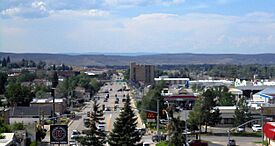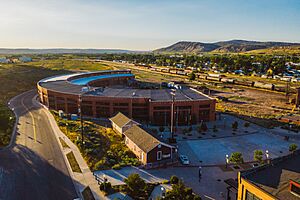Evanston, Wyoming facts for kids
Quick facts for kids
Evanston, Wyoming
|
|
|---|---|

Panorama of downtown Evanston along Front Street
|
|
| Motto(s):
Fresh Air, Freedom and Fun
|
|

Location of Evanston in Uinta County, Wyoming.
|
|
| Country | United States |
| State | Wyoming |
| County | Uinta |
| Founded | November 1868 |
| Incorporated | 1869 |
| Area | |
| • City | 10.305 sq mi (26.690 km2) |
| • Land | 10.265 sq mi (26.587 km2) |
| • Water | 0.040 sq mi (10.474 km2) |
| Elevation | 6,749 ft (2,057 m) |
| Population
(2020)
|
|
| • City | 11,747 |
| • Estimate
(2023)
|
11,807 |
| • Density | 1,150.73/sq mi (444.29/km2) |
| • Urban | 11,416 |
| • Metro | 23,415 (US: 485th) |
| Time zone | UTC−7 (Mountain (MST)) |
| • Summer (DST) | UTC−6 (MDT) |
| ZIP Codes |
82930, 82931
|
| Area code(s) | 307 |
| FIPS code | 56-25620 |
| GNIS feature ID | 1588345 |
| Highways | I-80, US-189, SR-89 and SR-150 |
| Sales tax | 5.0% |
Evanston is a city in Wyoming, United States. It is the main city of Uinta County. In 2020, about 11,747 people lived there. Evanston is located close to the border with Utah.
Contents
History of Evanston
Evanston was named after James A. Evans, an engineer for the Union Pacific Railroad. Some people think it was named after John Evans, who was a governor of Colorado. The town started when the first transcontinental railroad was being built. The railroad reached the area in November 1868.
At first, Evanston was a temporary "end of the tracks" town. Many people moved away when the railroad decided to move its main stop. But in June 1869, the railroad headquarters came back to Evanston. In 1871, a machine shop and a roundhouse were built. This helped Evanston stay a busy railroad town for a long time.
Evanston was important because it had lots of timber (wood) and water from the Bear River. This made it a good place for trains to refuel. Coal was also mined nearby in Almy. Many Chinese Railroad Workers lived in Evanston in a small "Chinatown" area. Over time, fewer Chinese people lived there.
Evanston was also a major stop on the Lincoln Highway, one of the first roads that went across the country. Today, Interstate 80 follows a similar path through the area.
In the 1980s, Evanston grew a lot because of an oil boom. More recently, drilling for natural gas has also helped the local economy. Old railroad buildings, like the roundhouse, have been restored in downtown Evanston. A replica of a Chinese temple, called a Joss house, was rebuilt in 1990. The original one had been destroyed in a fire.
Evanston's Geography and Climate
Evanston is located at about 41 degrees North latitude and 110 degrees West longitude. It is about 6,749 feet (2,057 meters) above sea level.
Major roads like Interstate 80 and US-189 pass through the city. State Routes 89 and 150 also serve Evanston.
The city covers about 10.3 square miles (26.7 square kilometers). Most of this area is land, with a small amount of water.
Evanston has a continental climate. This means it has long, cold, and dry winters. Summers are short, warm, and a bit more humid.
| Climate data for Evanston, Wyoming, 1991–2020 normals, extremes 1890–present | |||||||||||||
|---|---|---|---|---|---|---|---|---|---|---|---|---|---|
| Month | Jan | Feb | Mar | Apr | May | Jun | Jul | Aug | Sep | Oct | Nov | Dec | Year |
| Record high °F (°C) | 57 (14) |
70 (21) |
75 (24) |
82 (28) |
88 (31) |
94 (34) |
99 (37) |
94 (34) |
93 (34) |
80 (27) |
69 (21) |
64 (18) |
99 (37) |
| Mean maximum °F (°C) | 44.8 (7.1) |
47.5 (8.6) |
59.5 (15.3) |
69.7 (20.9) |
76.1 (24.5) |
83.7 (28.7) |
89.1 (31.7) |
86.5 (30.3) |
80.4 (26.9) |
72.8 (22.7) |
60.0 (15.6) |
48.4 (9.1) |
89.5 (31.9) |
| Mean daily maximum °F (°C) | 32.6 (0.3) |
34.5 (1.4) |
44.1 (6.7) |
53.1 (11.7) |
63.1 (17.3) |
73.2 (22.9) |
81.2 (27.3) |
79.6 (26.4) |
70.7 (21.5) |
57.9 (14.4) |
43.3 (6.3) |
32.7 (0.4) |
55.5 (13.1) |
| Daily mean °F (°C) | 21.8 (−5.7) |
24.0 (−4.4) |
32.6 (0.3) |
40.2 (4.6) |
48.9 (9.4) |
57.1 (13.9) |
64.4 (18.0) |
63.2 (17.3) |
54.7 (12.6) |
43.7 (6.5) |
31.2 (−0.4) |
21.9 (−5.6) |
42.0 (5.5) |
| Mean daily minimum °F (°C) | 11.1 (−11.6) |
13.4 (−10.3) |
21.1 (−6.1) |
27.2 (−2.7) |
34.6 (1.4) |
40.9 (4.9) |
47.6 (8.7) |
46.7 (8.2) |
38.6 (3.7) |
29.5 (−1.4) |
19.1 (−7.2) |
11.1 (−11.6) |
28.4 (−2.0) |
| Mean minimum °F (°C) | −8.5 (−22.5) |
−6.8 (−21.6) |
3.5 (−15.8) |
14.1 (−9.9) |
23.0 (−5.0) |
30.3 (−0.9) |
37.7 (3.2) |
36.9 (2.7) |
26.1 (−3.3) |
14.5 (−9.7) |
−0.5 (−18.1) |
−7.2 (−21.8) |
−14.0 (−25.6) |
| Record low °F (°C) | −35 (−37) |
−38 (−39) |
−30 (−34) |
−7 (−22) |
9 (−13) |
19 (−7) |
24 (−4) |
23 (−5) |
5 (−15) |
−8 (−22) |
−22 (−30) |
−34 (−37) |
−38 (−39) |
| Average precipitation inches (mm) | 0.84 (21) |
0.60 (15) |
0.74 (19) |
0.98 (25) |
1.89 (48) |
1.13 (29) |
0.77 (20) |
1.10 (28) |
1.17 (30) |
1.15 (29) |
1.04 (26) |
0.71 (18) |
12.12 (308) |
| Average snowfall inches (cm) | 13.2 (34) |
8.1 (21) |
5.0 (13) |
2.0 (5.1) |
1.0 (2.5) |
0.2 (0.51) |
0.0 (0.0) |
0.0 (0.0) |
0.3 (0.76) |
1.6 (4.1) |
6.1 (15) |
9.8 (25) |
47.3 (120.97) |
| Average precipitation days (≥ 0.01 in) | 5.1 | 6.1 | 5.1 | 7.1 | 7.1 | 5.7 | 4.3 | 5.9 | 5.4 | 5.7 | 5.9 | 6.1 | 69.5 |
| Average snowy days (≥ 0.1 in) | 4.6 | 3.9 | 2.0 | 0.9 | 0.4 | 0.0 | 0.0 | 0.0 | 0.1 | 0.9 | 4.1 | 4.1 | 21.0 |
| Source 1: NOAA (snow/snow days 1981–2010) | |||||||||||||
| Source 2: National Weather Service | |||||||||||||
People of Evanston
| Historical population | |||
|---|---|---|---|
| Census | Pop. | %± | |
| 1870 | 77 | — | |
| 1880 | 1,277 | 1,558.4% | |
| 1890 | 1,995 | 56.2% | |
| 1900 | 2,110 | 5.8% | |
| 1910 | 2,583 | 22.4% | |
| 1920 | 3,479 | 34.7% | |
| 1930 | 3,075 | −11.6% | |
| 1940 | 3,605 | 17.2% | |
| 1950 | 3,863 | 7.2% | |
| 1960 | 4,901 | 26.9% | |
| 1970 | 4,462 | −9.0% | |
| 1980 | 6,265 | 40.4% | |
| 1990 | 10,903 | 74.0% | |
| 2000 | 11,507 | 5.5% | |
| 2010 | 12,359 | 7.4% | |
| 2020 | 11,747 | −5.0% | |
| 2023 (est.) | 11,807 | −4.5% | |
| U.S. Decennial Census 1870–2020 Censuses 2020 Census |
|||
Population in 2020
In 2020, Evanston had 11,747 people living in 4,555 households. About 84% of the people were White. Other groups included African American, Native American, Asian, and Pacific Islander people. About 13.8% of the population was Hispanic or Latino.
The average age in Evanston was 36 years old. About 27.6% of residents were under 18.
Recent Information (2022)
In 2022, there were 4,628 households in Evanston. The average household had about 2.5 people. Most households (72.3%) owned their homes. The average household income was $70,825. About 6.4% of the people lived below the poverty line.
Most adults in Evanston have a high school diploma (93.3%). About 17.6% have a bachelor's degree or higher. People in Evanston come from many different backgrounds, including English, German, and American.
Arts and Culture in Evanston
Evanston hosts a Professional Rodeo Cowboys Association rodeo every year during an event called Cowboy Days. This takes place at the Uinta County Fairgrounds.
Historic Places to Visit
Nine places in or near Evanston are listed on the National Register of Historic Places. This means they are important historical sites. Some of these include:
- Bridger Antelope Trap
- Downtown Evanston Historic District
- A.V. Quinn House
- St. Paul's Episcopal Church
- Uinta County Courthouse
- Union Pacific Railroad Complex
- US Post Office – Evanston Main
- Wyoming State Insane Asylum
- Brigham Young Oil Well
Tourism and Attractions
The Uinta County Museum is located in downtown Evanston. It used to be a library built in 1906. It shows off a style of building called Classical Revival architecture.
You can also see a replica of a Chinese Joss house in Depot Square. This Joss House has a small model of Evanston's original "Chinatown" and other old items. Nearby is the Wing Family Gazebo and Garden, which has a Chinese-style pavilion, a pond, and a walking path.
Bear River State Park is just outside Evanston, next to Interstate 80. Here, you can watch wildlife, visit a visitors center, have a picnic, and walk on hiking trails. A path along the river connects to the Bear River Greenway in Evanston.
Sports and Recreation
Evanston has many parks and recreation facilities. The Bear River Greenway is a great place for a walk along the river. In winter, you can go ice skating, and in summer, you can fish or rent boats. There are also fitness trails.
Sulphur Creek Reservoir is a good spot for boating and fishing. Smaller parks around the city have basketball courts, soccer fields, tennis courts, sand volleyball, and playgrounds. The city's Recreation Center has a swimming pool and an indoor shooting range. It also offers classes in sports like martial arts, gymnastics, football, and soccer.
Education in Evanston
Public schools in Evanston are part of Uinta County School District #1. The district has eight schools:
- Four elementary schools (Aspen, Clark, North, and Uinta Meadows) for grades kindergarten through five.
- Two middle schools (Davis and Evanston) for grades six through eight.
- One high school (Evanston) for grades nine through twelve.
- One alternative high school (Horizon).
Evanston also has a branch of Western Wyoming Community College, which offers college courses. The city has a public library that is part of the Uinta County Library System.
Notable People from Evanston
- Jaycee Carroll (born 1983), a basketball player.
- Clarence D. Clark (1851–1930), a former United States Representative and United States Senator from Wyoming.
- Dana Perino (born 1972), who was the White House Press Secretary from 2007 to 2009.
- Brady Poppinga (born 1979), a former NFL linebacker.
- Kelly Poppinga (born 1982), a former NFL linebacker and now a coach.
- Winston Watts (born 1967), a bobsledder from Jamaica who competed in four Olympic Games.
- Ah Yuen (1850–1939), also known as "China Mary," one of the first Chinese immigrants to live in Evanston.
See also
 In Spanish: Evanston (Wyoming) para niños
In Spanish: Evanston (Wyoming) para niños


